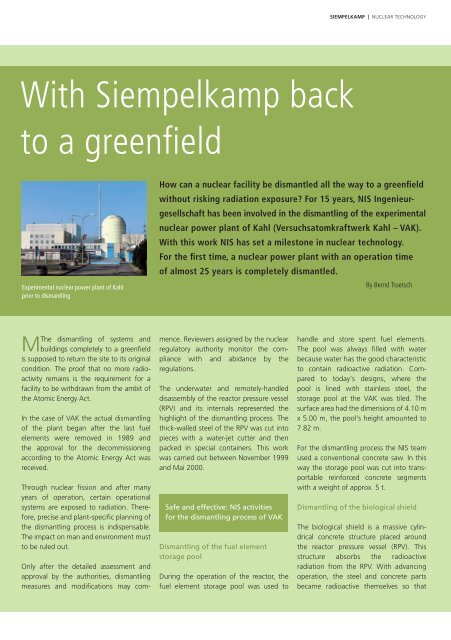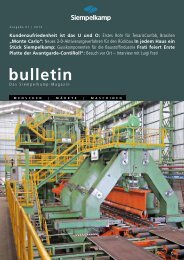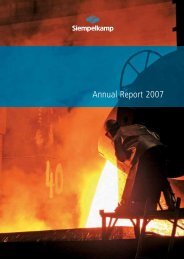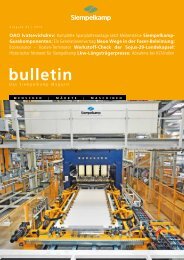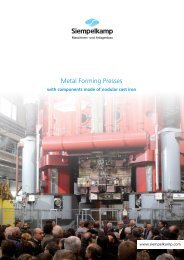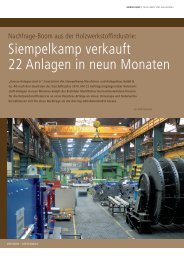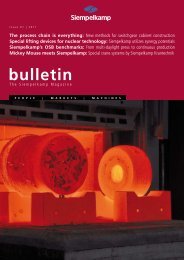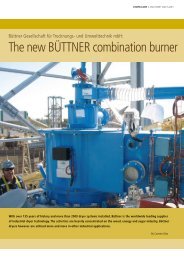Bulletin 2/2010 - Siempelkamp NIS
Bulletin 2/2010 - Siempelkamp NIS
Bulletin 2/2010 - Siempelkamp NIS
Create successful ePaper yourself
Turn your PDF publications into a flip-book with our unique Google optimized e-Paper software.
With <strong>Siempelkamp</strong> back<br />
to a greenfi eld<br />
Experimental nuclear power plant of Kahl<br />
prior to dismantling<br />
MThe dismantling of systems and<br />
buildings completely to a greenfi eld<br />
is supposed to return the site to its original<br />
condition. The proof that no more radioactivity<br />
remains is the requirement for a<br />
facility to be withdrawn from the ambit of<br />
the Atomic Energy Act.<br />
In the case of VAK the actual dismantling<br />
of the plant began after the last fuel<br />
elements were removed in 1989 and<br />
the approval for the decommissioning<br />
according to the Atomic Energy Act was<br />
received.<br />
Through nuclear fi ssion and after many<br />
years of operation, certain operational<br />
systems are exposed to radiation. Therefore,<br />
precise and plant-specifi c planning of<br />
the dismantling process is indispensable.<br />
The impact on man and environment must<br />
to be ruled out.<br />
Only after the detailed assessment and<br />
approval by the authorities, dismantling<br />
measures and modifi cations may com-<br />
mence. Reviewers assigned by the nuclear<br />
regulatory authority monitor the compliance<br />
with and abidance by the<br />
regulations.<br />
The underwater and remotely-handled<br />
disassembly of the reactor pressure vessel<br />
(RPV) and its internals represented the<br />
highlight of the dismantling process. The<br />
thick-walled steel of the RPV was cut into<br />
pieces with a water-jet cutter and then<br />
packed in special containers. This work<br />
was carried out between November 1999<br />
and Mai 2000.<br />
Safe and effective: <strong>NIS</strong> activities<br />
for the dismantling process of VAK<br />
Dismantling of the fuel element<br />
storage pool<br />
During the operation of the reactor, the<br />
fuel element storage pool was used to<br />
SIEMPELKAMP | NUCLEAR TECHNOLOGY<br />
How can a nuclear facility be dismantled all the way to a greenfi eld<br />
without risking radiation exposure? For 15 years, <strong>NIS</strong> Ingenieurgesellschaft<br />
has been involved in the dismantling of the experimental<br />
nuclear power plant of Kahl (Versuchsatomkraftwerk Kahl – VAK).<br />
With this work <strong>NIS</strong> has set a milestone in nuclear technology.<br />
For the fi rst time, a nuclear power plant with an operation time<br />
of almost 25 years is completely dismantled.<br />
By Bernd Truetsch<br />
handle and store spent fuel elements.<br />
The pool was always fi lled with water<br />
because water has the good characteristic<br />
to contain radioactive radiation. Compared<br />
to today's designs, where the<br />
pool is lined with stainless steel, the<br />
storage pool at the VAK was tiled. The<br />
surface area had the dimensions of 4.10 m<br />
x 5.00 m, the pool's height amounted to<br />
7.82 m.<br />
For the dismantling process the <strong>NIS</strong> team<br />
used a conventional concrete saw. In this<br />
way the storage pool was cut into transportable<br />
reinforced concrete segments<br />
with a weight of approx. 5 t.<br />
Dismantling of the biological shield<br />
The biological shield is a massive cylindrical<br />
concrete structure placed around<br />
the reactor pressure vessel (RPV). This<br />
structure absorbs the radioactive<br />
radiation from the RPV. With advancing<br />
operation, the steel and concrete parts<br />
became radioactive themselves so that


